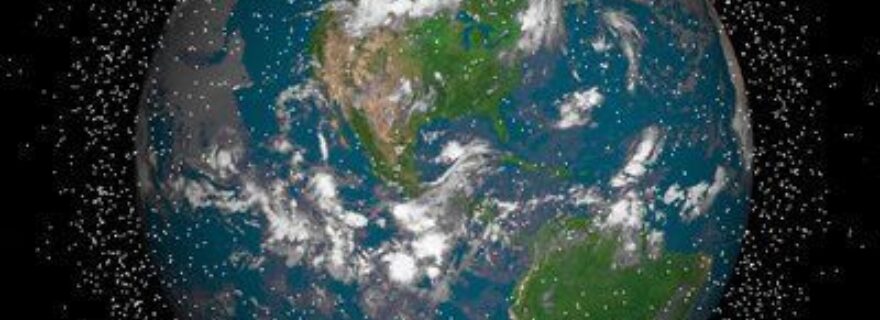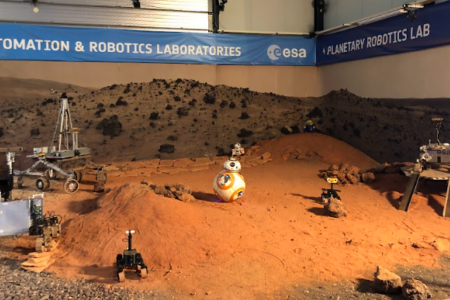The trash problem above our heads
Space trash: it's a problem that concerns all of us, more than we might realise. Why exactly?
It could have happened on a busy highway, a pasture or even in a residential area: a metal rocket section, thirty meters long, fell from space with a couple of thousand kilometers per hour and could destroy everything in its path. A Chinese rocket, Long March 5B, was launched on April 29th without any problems. However, shortly after the launch a part of the rocket fell back to Earth instead of trailing along to space. For days no one knew where the debris would hit the planet. It was estimated to crash between the latitudes of New York and Wellington in New Zealand. This means that about seven billion people risked getting a rocket on their roof, just because a country neglected tidying their space debris. Fortunately, the wreckage fell in the Indian Ocean on May 9th, without any major accidents. The event raised questions from many people. How could this have happened? What would have happened if it had crashed in a populated area? Are we taking space debris serious enough?
Starting with this last question,the answer is quite simple: no. Historically, space missions have not been built on sustainability for decades. Recent developments in reusable rocket programs such as SpaceX are a welcome change. Other potential new missions of the European Space Agency ESA will capture old, unused satellites using nets. Then the satellites will be destroyed by pulling them to Earth, where they will evaporate in the atmosphere. This does not take away that most space missions still create lots of space debris. Since the launch of the Russian Sputnik 1 in 1957, over 6000 space missions have been completed of which only a handful did not leave any or barely any debris behind. Almost every space mission consists of a phase in which large parts of the rocket are released or shot off. In this process, thousands of small pieces of paint, metal or other debris come free. Countries have drafted rules to limit this, nonetheless a substantial amount of debris is still released at every launch. Launching has increased, without taking drastic actions against the waste we leave behind. However, an increasing number of space travel companies and organizations are now committed to creating sustainable space travel. Sadly, this does not solve the problem of all the debris that is already present in space.
The ESA estimates that over 128 million pieces of space debris bigger than a millimeter rotate around the Earth. Each of these pieces, however small, could be dangerous for satellites. The high speed of about 42000 km/u makes even small objects a threat. A lick of paint can hit a fragile satellite as hard as a bullet could on Earth. However, not only small debris pieces can be a danger, broken or old satellites that are no longer used can also collide with active space devices. For example, a collision happened between an unused Soviet probe Kosmos 2251 and the Iridium 33, which Russians used for telecommunication, in 2009. Despite the computing power of modern computers, the predicted paths of these satellites were wrongly calculated. They should have missed each other by 500 meter, but hit full frontal and were ripped to pieces. It had relatively few consequences for Russian callers, because the Iridium 33 was a part of a bigger group of satellites with the same function. The impact would have been far greater for countries that rely only a couple of satellites for their telecommunication. Collisions are scarce, but nonetheless real and dangerous.
The international space station ISS has been cleared once when a satellite was predicted to hit it. Performing maneuvers to avoid hitting each other is an insanely precise progress. First of all, there has to be a reason to dodge, after which it is determined which party should sidestep. Finally, valuable fuel is used to dodge the other party. Afterwards, it often turns out that the dodging was not necessary at all, as the devices would have missed each other anyway. Satellites such as the Hubble Space Telescope, being the most expensive telescope ever built with a price tag of nine billion dollars, ideally avoids collisions. Otherwise the high-quality astronomical research that is performed with the telescope all day long for 11,000 euros per second would need to be put on hold. If any damage still does occur, who is then responsible for it?
According to professor of space law at Leiden University Tanja Masson-Zwaan there are many non-binding, international declarations and treaties about this topic that are supported by all the big players on the spatial world stage. A company that wants to launch objects to space makes thorough, binding agreements with the country from which they operate. These agreements are about waste reduction, liability and responsible use of space. Eventually, this means that a country can be held accountable for any potential harm or accidents and they can be sent to the International Court of Justice in Den Haag by the accusing parties. Fortunately, though unfortunate from a judicial perspective, this has never happened. No major accidents have taken place, but as a consequence no case law exists. Therefore a first case would be extra interesting, as it would create clarity on the consequences of neglecting space.
For now the situation is not yet distressing, but it is concerning. Countries have not made any large, binding, international treaties for years now, as no country wants to give up their sovereignty for the greater good. This causes pressure for national authorities to demand stricter requirements from space travel companies. Despite all this, space waste is not a hot topic in politics, even though the problem slowly grows. Let’s hope the rules on space waste grow quicker than the problem.






0 Comments
Add a comment